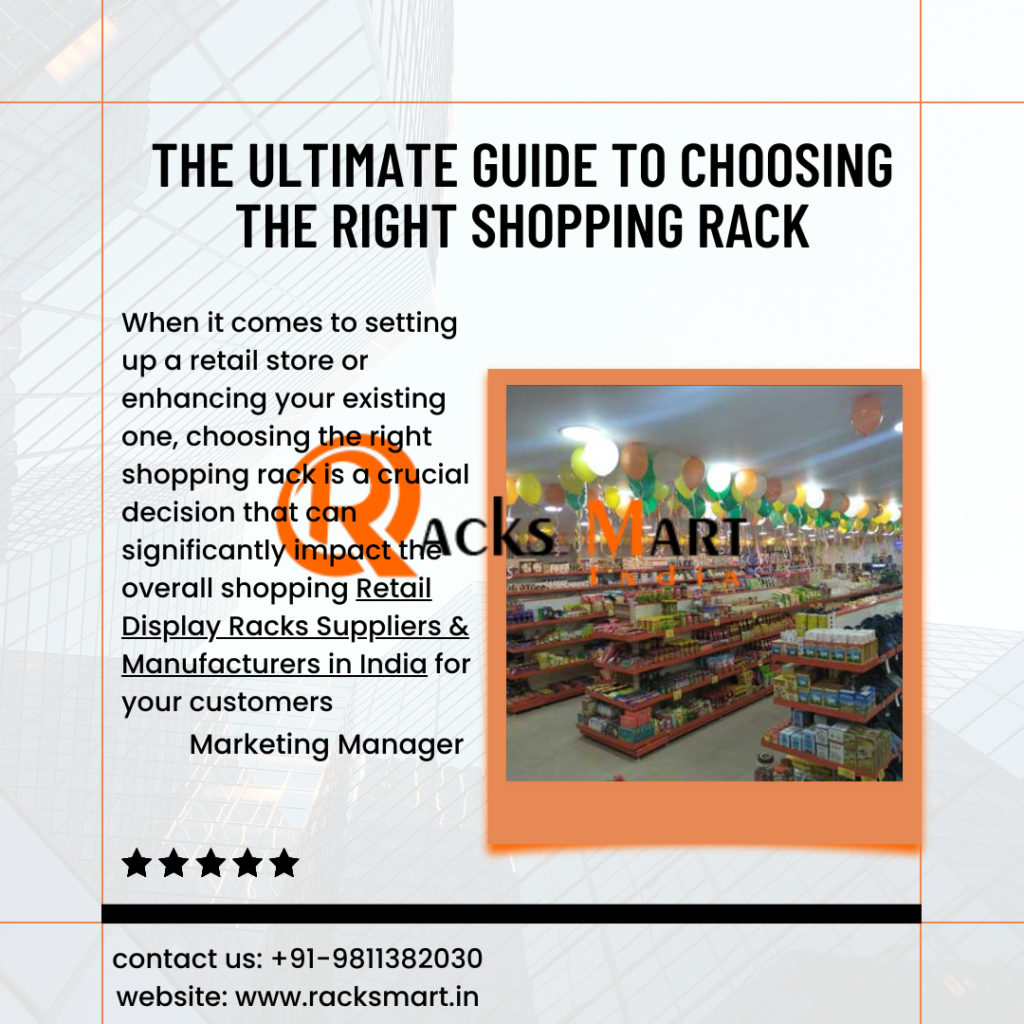When it comes to setting up a retail store or enhancing your existing one, choosing the right shopping display rack is a crucial decision that can significantly impact the overall shopping for your customers. A well-designed and strategically placed shopping rack not only helps you display your products effectively but also creates an inviting ambiance that encourages customers to explore and make purchases. In this ultimate guide, we will walk you through the important factors to consider when selecting the right shopping rack that meets your specific needs and helps you outrank your competition.

1. Understanding Your Store Layout and Space
Before diving into the details of different types of shopping racks, it’s essential to evaluate your store’s layout and available space. Analyze the dimensions, traffic flow, and overall aesthetics of your store to determine the ideal placement and size of the racks. Measure the available floor area and take note of any architectural constraints that might affect the rack’s positioning. By understanding your store’s unique characteristics, you can choose a shopping rack that maximizes both functionality and visual appeal.
2. Assessing Your Product Range and Display Requirements
Every retail store has its own product range and display requirements. Take stock of the types of products you sell and identify their specific display needs. Are you selling clothing items that require hanging racks, or do you specialize in small accessories that benefit from countertop or shelf displays? Understanding the dimensions, weight, and presentation style of your products will guide you in selecting the appropriate shopping rack options for effective showcasing.
3. Exploring Different Shopping Display Rack Styles
- a) Hanging Racks: If you primarily sell apparel or garments, hanging racks are an excellent choice. They provide ample space for displaying clothing items in an organized and easily accessible manner. Look for racks with adjustable height and width options to accommodate different sizes and styles of garments.
- b) Shelving Racks: Shelving racks are versatile and suitable for various product categories. They come in different sizes, materials, and configurations, such as wall-mounted shelves, freestanding units, or gondolas. Consider factors like weight capacity, adjustability, and ease of installation when selecting shelving racks.
- c) Countertop Displays: Ideal for small, high-value items or impulse buys, countertop displays create focal points near cash registers or high-traffic areas. Choose displays that are compact, visually appealing, and provide easy access to the products. Consider rotating or tiered designs to maximize the use of limited space.
- d) Slat wall Systems: Grid wall or slat wall systems offer tremendous flexibility for displaying a variety of products. These versatile systems allow you to attach hooks, shelves, and other accessories to customize the display according to your specific needs. Consider the installation process and the ability to reconfigure the layout as your product range evolves.
4. Balancing Aesthetics and Functionality
While functionality is crucial, the aesthetics of your shopping racks play a significant role in attracting and engaging customers. Consider the overall theme and branding of your store when selecting rack designs. Opt for finishes, materials, and colors that complement your store’s ambiance and product offerings. A visually appealing shopping rack can enhance the perceived value of your products and create a memorable shopping experience.
5. Durability and Maintenance
Investing in high-quality shopping racks ensures their longevity and minimizes maintenance costs over time. Look for racks made from durable materials like stainless steel, wood, or high-grade plastic. Consider the weight-bearing capacity of the racks, especially if you plan to display heavier items. Additionally, prioritize racks that are easy to clean and maintain to keep your store looking tidy and professional.
6. Optimizing Rack Placement for Maximum Impact
Strategic placement of shopping racks can significantly impact your store’s traffic flow and sales. Position racks near the entrance or in high-visibility areas to capture customers’ attention and draw them deeper into the store. Create attractive displays at eye level to encourage browsing and impulse purchases. Utilize end caps and feature displays to highlight new or promotional items. Regularly analyze customer movement patterns and adapt rack placements accordingly to optimize sales potential.
7. Staying Informed About Industry Trends
The retail industry is constantly evolving, and it’s important to stay informed about the latest trends in shopping rack designs and concepts. Attend trade shows, read industry publications, and explore online resources to discover innovative ideas for store layout and visual merchandising. By staying ahead of the curve, you can continuously update and improve your store’s aesthetics and product displays, giving you an edge over your competitors.
In conclusion, choosing the right shopping rack is a critical aspect of creating a successful retail store. By understanding your store’s layout, product range, and display requirements, you can select racks that optimize functionality and aesthetics. Explore various styles, balancing hanging racks, shelving racks, countertop Racks Suppliers in India, and gridwall or slatwall systems, based on your specific needs. Focus on durability, maintenance, and strategic placement to create an inviting and engaging shopping environment. By implementing these strategies, you can enhance your store’s visual appeal, boost customer satisfaction, and ultimately outrank your competition.


